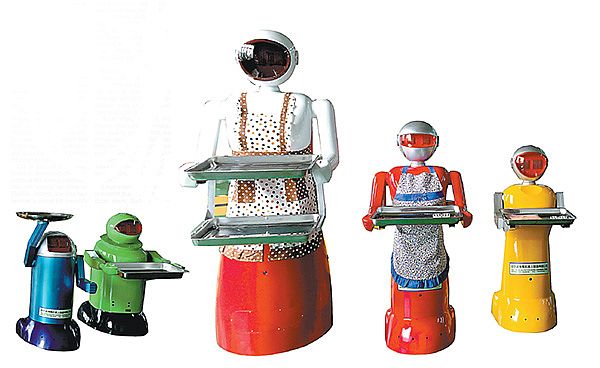‘Robo chefs’ dish up the perfect solution

Chef robots in different colors and sizes, which are designed by Harbin-based Haiying Robot Manufacturing Company. (Photo provided to China Daily)
High-tech companies have turned Harbin, the capital and largest city of Heilongjiang province in China, into a center for research and development in automated machines.
It might seem more like science fiction than science fact, but a Chinese company has been developing a range of “robo chefs” for cafeterias and restaurants.
The Haiying Robot Manufacturing Company turns out more than 1,000 automated “cooks” annually, which cost 100,000 yuan (US$15,748) each, at its factory in Harbin.
A weird-looking device, the robotic chefs have two high-tech arms that can each whip up 40 different Chinese dishes, including sweet and sour chicken, fried potatoes with green peppers, noodles and dumplings.
Liu Hasheng, who comes from Harbin and is the founder of the company, created the automated arms.
His plan as general manager is to export robo chefs to the United States, Germany, and Singapore.
“We plan to take the robotic components to the United States, and assemble the spare parts there,” Liu, 53, said. “Some of the robots are designed to cook Americanized Chinese food with sweetened flavors.”
Apart from the US, other potential markets are Germany and Singapore, according to Haiying Robot Manufacturing.
“The company is currently looking at an American operation, since Chinese food is extremely popular in the US,” Liu said. “Our robot chefs will help to standardize the flavors, and make those dishes perfect for American tastes.”
Liu is part of a growing breed of innovative entrepreneurs in the robotics industry that are setting up shop in Harbin. Indeed, the city has become a center for research and development in automated machines.
Last year, annual revenue from the robotic industry was 1.25 billion yuan. From 2008 to 2013, the industry witnessed a 20 per cent annual increase in revenue, data from the city government showed.
With the help of the Harbin Institute of Technology and the city’s robot industrial park, the sector has grown considerably, and there are now 57 companies working in the business.
Last year, China overtook Japan to become the largest buyer of industrial robots after purchasing 57,000 automated machines, an increase of 55 per cent compared to 2013.
This accounted for a quarter of global sales, according to China Robot Industry Alliance, an industry body based in Beijing.
Under the “Made in China 2025” national plan, which is designed to turn the country into a high-tech manufacturing powerhouse, the automated machines industry has expanded quickly.
For innovators such as Liu, this has been great news after working in the sector for 28 years. Previously, he was involved in the development of unmanned aerial vehicles or drones.
But his life really changed in 2008 when he came up with the “robotic chef” idea. He even opened up his first restaurant with an automated cook in Harbin in 2012.
“Back then, one of my friends who owned a restaurant said it was difficult for him to hire qualified staff and keep them, due to high labor costs,” he recalled. “I started to consider if I could create a ‘robot cook’ that would be able to do simple, repetitive kitchen jobs.”
It was a moment of inspiration and it paid off. In the past three years, Haiying Robot Manufacturing has taken off with a steady stream of orders from restaurants across China.
“So far, I have sold robot chefs to more than 60 restaurants nationwide, including areas in western China, such as Gansu and Ningxia Hui autonomous region,” Liu said. “The labor-saving devices are designed to speak different dialects and cook local cuisines to cater for various regions.”
But Liu has not stopped there. His company plans to roll out “robo waiters”, which cost 40,000 yuan each. They usually have a “working life span” of about eight to 10 years. “They are built to last,” he said.
Next year, he plans to manufacture between 6,000 to 8,000 robots annually, worth more than 100 million yuan, although he has yet to disclose detailed financial figures for the company.
Other projects include turning out “family robot chefs” for consumers in the near future, as well as launching a central processing factory to produce processed food materials for supermarket chains. These products can then be popped into the oven by robot chef.
Still, Haiying Robot Manufacturing will have to stay on its toes as the competition is fierce.
Discoverer Robot Co Ltd is based in Daqing, Heilongjiang province, and was founded in 2012. It now sells a few hundred robotic chefs a year to college cafeterias, companies and the People’s Liberation Army.
“There is a huge market potential for robot chefs at home and abroad,” Ge Wenhua, chairman of Discoverer, said. “Many senior citizens are in a bad health and can’t cook, while the younger generation don’t know how to cook. They will all need robot chefs.”
Cost-saving is also a major incentive for cafeterias and companies looking to buy Discoverer’s automated chefs.
“A robot cook can help save operational costs of about 200,000 yuan annually, according to our research of college cafeterias,” Ge said. “And a robot can be more efficient and environmentally friendly,” he added.
They also never take a lunch break.
How robot cook works
– The robotic cook has highly precise movements.
– It can put together an entire dish, step-by-step.
– The automated arms can place food in fryers, add water and measure ingredients and condiments.
– It can interact with other electrical kitchen equipment, such as pancake turners and blenders.
– It can speak different dialects and cook local cuisines.